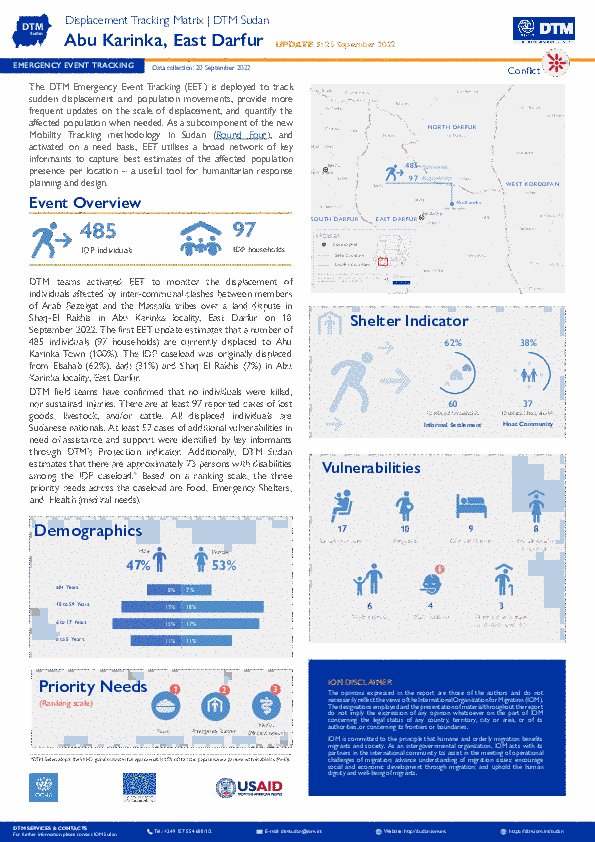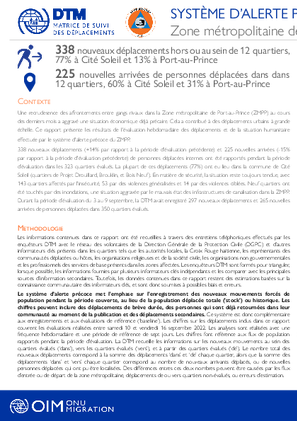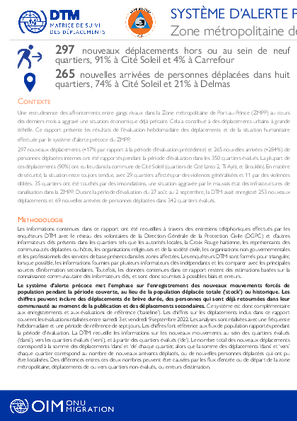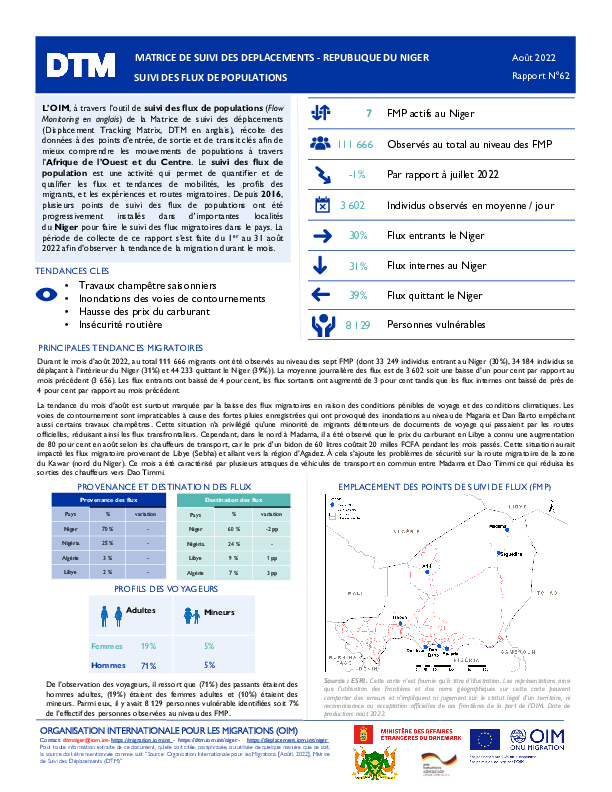-
Countries
-
Data and Analysis
-
Special Focus
-
Crisis Responses

Contact
DTMUkraine@iom.int
Language
Ukrainian
Location
Ukraine
Period Covered
Sep 05 2022
Sep 18 2022
Activity
- Baseline Assessment
Починаючи з 24 лютого 2022 року війна в Україні спричинила безпрецедентну гуманітарну кризу в усіх адміністративних підрозділах (областях) країни.
З 5 по 18 вересня Міжнародна організація з міграції (МОМ) провела базову оцінку території 994 громад*, які приймають зареєстрованих внутрішньо переміщених осіб у 21 області та в місті Києві, щоб отримати загальне уявлення про внутрішнє переміщення.
Проведення цієї оцінки підтримує цільове призначення та надання гуманітарної допомоги постраждалому населенню і служить попереднім джерелом для виявлення громад з високим рівнем переміщення.
Зібрано інформацію про понад 3 176 000 прибулих у 21 області та в місті Києві, охоплених 12 туром базової оцінки території командою МВП.

Contact
DTMUkraine@iom.int
Language
English
Location
Ukraine
Period Covered
Sep 05 2022
Sep 18 2022
Activity
- Baseline Assessment
Starting on 24 February 2022, the war in Ukraine triggered an unprecedented humanitarian crisis across the country. Between 5 September and 18 September the International Organization for Migration (IOM) conducted an Area Baseline assessment of 994 hromadas* hosting IDPs in 21 oblasts and Kyiv City in order to gather initial trends on the number and precise geographic location of officially recorded internally displaced persons.
This routine assessment supports the targeting and provision of humanitarian assistance to the affected population and serves as a key source to identifying oblasts and hromadas hosting high numbers of IDPs.
IOM compiled information on more than 3,176,000 in the 21 oblasts (in addition to Kyiv City) covered by Round 12 of DTM Area Baseline.
Contact
DTM Yemen, iomyemendtm@iom.int
Location
Yemen
Activity
- Mobility Tracking
- Event Tracking
Period Covered
Sep 18 2022 -Sep 24 2022
From 1 January to 24 September 2022, IOM Yemen DTM tracked 8,896 households (HH) (53,376 Individuals) who experienced displacement at least once.
Between 18 and 24 September 2022, IOM Yemen DTM tracked 60 households (360 individuals) displaced at least once. The majority of people moved into/within the following governorates and districts:
- Marib (38 HHs) – Marib City (34 HHs), Marib (4 HHs) districts. Most displacements in the governorate originated from Shabwah and Taiz.
- Taiz (10 HHs) – Jabal Habashi (7 HHs), Al Misrakh (2 HHs), Al Makha (1 HH) districts. Most displacements in the governorate originated from Taiz and Sanaa City.
- Abyan (4 HHs) – Khanfar (4 HHs) district. All displacements in the governorate originated from Al Hodeidah.
- Taiz (14 HHs) – Maqbanah (6 HHs), Sabir Al Mawadim (4 HHs), Jabal Habashi (2 HHs) districts.
- Al Hodeidah (10 HHs) – Zabid (4 HHs), Al Marawiah (2 HHs), Al Jarrahi (2 HHs) districts.
- Shabwah (10 HHs) – Ataq (10 HHs) district.
Population Groups
Survey Methodology
Unit of Analysis Or Observation
Type of Survey or Assessment
Keywords
Geographical Scope
Administrative boundaries with available data
The current dataset covers the following administrative boundaries
Contact
DTMDRC@iom.int
Location
Democratic Republic of the Congo
Activity
- Mobility Tracking
- Baseline Assessment
Period Covered
Jul 06 2022 -Aug 10 2022
A baseline assessment is a sub-component of mobility tracking. It aims to collect data on IDP, migrant or returnee population presence in a defined administrative area of the country.
Population Groups
Survey Methodology
Unit of Analysis Or Observation
Type of Survey or Assessment
Keywords
Geographical Scope
Administrative boundaries with available data
The current dataset covers the following administrative boundaries

Contact
DTM Sudan; dtmsudan@iom.int
Language
English
Location
Sudan
Snapshot Date
Sep 20 2022
Activity
- Mobility Tracking
- Event Tracking
The DTM Emergency Event Tracking (EET) is deployed to track sudden displacement and population movements, provide more frequent updates on the scale of displacement, and quantify the affected population when needed. As a subcomponent of the new Mobility Tracking methodology in Sudan (Round Four), and activated on a need basis, EET utilises a broad network of key informants to capture best estimates of the affected population presence per location – a useful tool for humanitarian response planning and design

Contact
dtmhaiti@iom.int
Language
English
Location
Haiti
Period Covered
Sep 10 2022
Sep 16 2022
Activity
- Event Tracking
Une recrudesence des affrontements entre gangs rivaux dans la Zone métropolitaine de Port-au-Prince (ZMPP) au cours des derniers mois a aggravé une situation économique déjà précaire. Cela a contribué à des déplacements urbains à grande échelle. Ce rapport présente les résultats de l'évaluation hebdomadaire des déplacements et de la situation humanitaire effectuée par le système d'alerte précoce du ZMPP.
338 nouveaux déplacements (+14% par rapport à la période d'évaluation précédente) et 225 nouvelles arrivées (-15% par rapport à la période d'évaluation précédente) de personnes déplacées internes ont été rapportés pendant la période d’évaluation dans les 323 quartiers évalués. La plupart de ces déplacements (77%) ont eu lieu dans la commune de Cité Soleil (quartiers de Projet Drouillard, Brouklin, et Bois Neuf). En matière de sécurité, la situation reste toujours tendue, avec 143 quartiers affectés par l'insécurité, 53 par des violences généralisées et 14 par des violences ciblées. Neuf quartiers ont été touchés par des inondations, une situation aggravée par le mauvais état des infrastructures de canalisation dans la ZMPP. Durant la période d’évaluation du 3 au 9 septembre, la DTM avait enregistré 297 nouveaux déplacements et 265 nouvelles arrivées de personnes déplacées dans 350 quartiers évalués.

Contact
dtmhaiti@iom.int
Language
English
Location
Haiti
Period Covered
Sep 03 2022
Sep 09 2022
Activity
- Event Tracking
Une recrudesence des affrontements entre gangs rivaux dans la Zone métropolitaine de Port-au-Prince (ZMPP) au cours des derniers mois a aggravé une situation économique déjà précaire. Cela a contribué à des déplacements urbains à grande échelle. Ce rapport présente les résultats de l'évaluation hebdomadaire des déplacements et de la situation humanitaire effectuée par le système d'alerte précoce du ZMPP.
297 nouveaux déplacements (+17% par rapport à la période d'évaluation précédente) et 265 nouvelles arrivées (+284%) de personnes déplacées internes ont été rapportés pendant la période d’évaluation dans les 350 quartiers évalués. La plupart de ces déplacements (90%) ont eu lieu dans la commune de Cité Soleil (quartiers de Cité Linto 2, Ti Ayiti, et Brouklin). En matière de sécurité, la situation reste toujors tendue, avec 29 quartiers affectés par des violences généralisées et 11 par des violences ciblées. 35 quartiers ont été touchés par des innondations, une situation aggravée par le mauvais état des infrastructures de canalisation dans la ZMPP. Durant la période d’évaluation du 27 août au 2 septembre, la DTM avait enregistré 253 nouveaux déplacements et 69 nouvelles arrivées de personnes déplacées dans 342 quartiers évalués.

Contact
DTM Niger, DTMNiger@iom.int
Language
English
Location
Niger
Period Covered
Aug 01 2022
Aug 31 2022
Activity
- Flow Monitoring
Le suivi des flux de population est une activité qui permet de quantifier et de qualifier les flux et tendances de mobilités, les profils des migrants, et les expériences et routes migratoires. Ce rapport présente les données recueillies à travers l'enregistrement des flux de populations entre le 1er et le 31 août 2022 aux sept points de suivi des flux (FMP) du Niger, reflétant les tendances migratoires observées dans le pays au cours du mois.

Contact
DTM Guinée, oimguineedtm@iom.int
Language
French
Location
Guinea
Period Covered
Aug 01 2022
Aug 31 2022
Activity
- Flow Monitoring
Afin de mieux comprendre les mouvements et tendances migratoires en Afrique de l’Ouest et du Centre, l’OIM, à travers la Matrice de suivi des déplacements (Displacement Tracking Matrix, DTM), met en œuvre l’activité de Suivi des flux de populations (Flow Monitoring, FM). Le suivi des flux, qui est mis en œuvre en étroite collaboration avec les autorités et des partenaires nationaux et locaux, est composé de deux outils: l’enregistrement des flux (Flow Monitoring Registry, FMR) et les enquêtes individuelles (Flow Monitoring Survey, FMS). Il récolte des données clés sur les flux migratoires, les profils des voyageurs, les parcours et intentions des migrants, afin de fournir une meilleure compréhension des flux migratoires dans la région.
En août 2022, 18 674 voyageurs ont été observé au niveau des FMP de Boundoufourdou (préfecture de Koundara) dans le nord du pays, de Kourémalé et Nafadji (préfecture de Siguiri) dans le nord-est de la Guinée. Parmi les voyageurs, 9 614 passagers entraient en Guinée et 9 060 individus sortaient de la Guinée

Contact
DTM Guinée, oimguineedtm@iom.int
Language
French
Location
Guinea
Period Covered
Feb 01 2022
Apr 30 2022
Activity
- Flow Monitoring Survey
La transhumance est une méthode d’élevage par laquelle les éleveurs accompagnent leurs troupeaux à la recherche de pâturages et de points d’eau. Le changement climatique, la situation économique morose et la diminution des pâturages et point d’eau ont accentué ce phénomène, poussant les transhumants à parcourir de plus longues distances. Des couloirs de passage sont aménagés pour faire place au passage des animaux dans les zones de culture ou pour leur offrir un accès à l’eau. Le déplacement des troupeaux le long de ces couloirs peut affecter les récoltes des paysans. Ces dernières années, les conflits entre agriculteurs et éleveurs le long des couloirs de transhumance sont devenus de plus en plus récurrents. Pour fournir plus d’informations sur les mouvements de transhumance, l’OIM a développé l’outil de Suivi de transhumances (Transhumance Tracking Tool, TTT). Ce rapport présente le résultat des collectes effectuées par les énumérateurs au niveau de 11 points stratégiques dans les sous-préfectures de : Sandéniah, Herémakonon et Songoyah, en charge de comptabiliser le nombre d'animaux passant la frontière dans le but de fournir une estimation des flux de transhumances entre la Guinée et la Sierra Leone au cours des mois de février, mars et avril 2022.
